Navigating New York with the “City of Women” Map
Editor's note: A version of this post originally appeared on Nightingale, a publication by the Data Visualization Society.
Cities are defined by the place, the people, and how they makes us feel. New York City is known as the “City that never sleeps,” the land of opportunity where you have to hustle to make your dreams come true. I have the privilege of calling this concrete jungle home. That means my lens for this city is dipped in nostalgia as I walk through midtown and point out all of the office buildings I worked in throughout the years or when I go check in on Central Park or Rockefeller Center and see how much has changed but remained the same.
Another city I like to explore is the one underneath—the subway. New Yorkers have a love-hate relationship with the subway with its constant delays but there is definite affection for it. For $2.75 you can travel across 665 miles of track and experience four of the five boroughs. You can start in the Bronx and end up in Coney Island, Brooklyn. The subway is truly the life blood for New Yorkers. We use the train to work, play, and catch up with friends. I couldn’t imagine life without the NYC Subway. The subway IS New York.
I had the opportunity to check out NY Transit Museum’s Navigating New York exhibit. This exhibit celebrates NYC’s increased development paralleled by the growing transit systems through a collection of maps dating back to the 19th century. The cool thing about this museum is that it’s located in a decommissioned subway station!
I didn’t expect my trip to the transit museum to show me NYC through the lens of women who have impacted our city. I found a NYC subway map that replaced the name of the subway stops with women like Mary J. Blige, Alicia Keys, and Carly Simon. It was one of the most memorable and impactful pieces from my visit—a map that had me wondering how Lena Horne and Ella Fitzgerald ended up in Queens or Edie Falco along the G route in Brooklyn.
"Navigating New York tells the wonderful story of how maps have been used to passively provide a sense of place, to actively encourage—and many would argue steer—individual transportation choices and to become the canvas from which artists draw inspiration, and in so doing, maps reflect the story of how New York, as we know it, came to be."
The “City of Women” map, co-created by Rebecca Solnit and Joshua Jelly Schapiro, is based off of the iconic Vignelli subway map and names each station for a woman who left a mark in the “city that never sleeps.” Rebecca Solnit is the author of many books including Savage Dreams, Storming the Gates of Paradise, and the best-selling atlases Infinite City and Unfathomable City. Schapiro is a geographer and writer whose work often focuses on place, race, and how human difference is thought about and acted on in the world. He is the author of Island People: The Caribbean and the World (Knopf, 2016) and the co-editor, also with Rebecca Solnit, of Nonstop Metropolis: A New York City Atlas (California, 2016) which includes the City of Women map. Since 2014, he has been a visiting scholar at the Institute for Public Knowledge at NYU, where he also teaches.
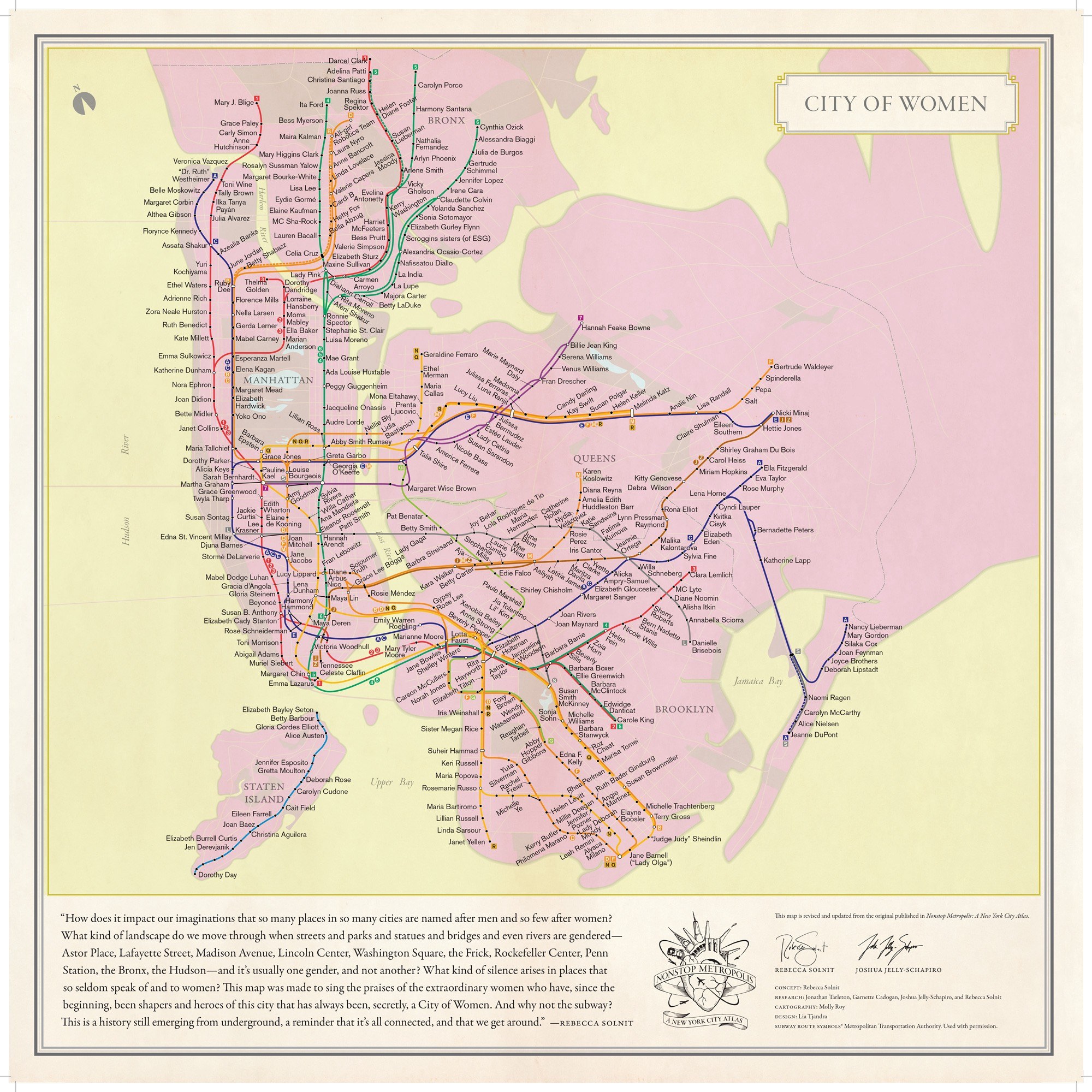
Cities are defined by the place, the people, and how they make us feel. NYC is known as a city of opportunity, innovation, creativity and strength. It’s a place you have to hustle to make your dreams come true. The women that Rebecca Solnit and Joshua Jelly-Schapiro have showcased on this map have broken barriers and become heroes in their own right.
I had a chance to talk with Joshua about the map and what inspired its creation. I was excited to learn about the process of selecting women for the subway stations for the original map and the recently updated version 2.0. I also wanted to talk about the women I came across as I navigated this great map.
Allen Hillery: Hi Joshua! Thanks so much for taking the time to discuss “City of Women”! I’m glad we have the opportunity to talk about this amazing map. I thought using the subway map to honor these women was a nice touch. Are you from New York?
Joshua Jelly-Schapiro: No, neither Rebecca, my co-creator, or I are from New York originally, but both of us, like many Americans, have families whose stories in this country run through New York, via Ellis Island and settling nearby (both of us have parents and grandparents who grew up here), and I’ve been spending time in the city my whole life.
AH: What drew you to New York specifically?
JJS: I personally moved here to live seven years ago now, not least to work on this project. But one thing I’ve always felt about New York, in comparison to other cities (and apropos of the subway map!) is that it’s really a city whose story you can join quite quickly—whether you’re an immigrant who’s just landed at JFK, or a student starting school, you get on the A train and start complaining about how late it’s running: Well, pretty quickly, you’re a New Yorker!
AH: Let’s talk about the “City of Women” map. What was the inspiration behind creating it?
JJS: The original map was one of 26 imaginative maps of NY that Rebecca Solnit and I created for NONSTOP METROPOLIS: A NEW YORK CITY ATLAS. Rebecca proposed the idea for “City of Women,” and we worked with our atlas team to bring it to fruition. Our aim, with every map we make, is to show how powerful maps can alter our perceptions of place and help to surface hidden histories, truths, and stories.
AH: That’s definitely a recurring theme that resonates from the Navigating New York exhibit on how maps have been used to provide a sense of place. How does “City of Women” provide that?
JJS: The original “City of Women” map was an implicit comment on how the vast majority of places in NYC—as in most cities— are named after men. Streets, parks, squares, you name it...we live, as Rebecca puts it, in a “manscape.” So the idea behind the “City of Women” map was to ask how our perceptions of the city, and of public space, might shift if we created a map that honored the irreplaceable and unheralded contributions of women to the city’s history and present. And what better—or more fun—map to use, and to tweak, than the one New Yorkers know best? So the concept, which we then set out to execute, was to rename every stop on the subway map (or nearly every stop, anyway!) for an illustrious NYC woman.
AH: That’s about over 400 subway stations! I think it’s great to spotlight and honor so many women! You almost have to wonder why it’s taken so long. Where do you even begin with selecting which women to honor?
JJS: We’ve gone from 200-something names on the first map to over 300 on this one, so it is a leap! It was important to us to celebrate and honor women from many different fields and endeavors, all whom have shaped the history and present of NYC. From performers to politicians to scientists to activists to artists—we wanted them all on the map. And we were especially determined to celebrate and honor women who haven’t gotten their due, or have excelled in fields not often identified with women.
AH: How long did it take to compile the list of women on the map?
JJS: The first time around, when we were completing the map for Nonstop Metropolis, was a few months of research. The second time out, as we sought to fill in and add to what we’d done, was the same. A lot of time on the internet and in the library, but also just calling and talking with people around the city who love particular communities or corners of it.
AH: Going back to your earlier comment on celebrating and honoring women who haven’t gotten their due, there are several women popping out on this map that I definitely want to discuss with you. One woman who stood out initially to me was Sojourner Truth. I knew of her but had no idea she was from NY let alone spent time in NYC.
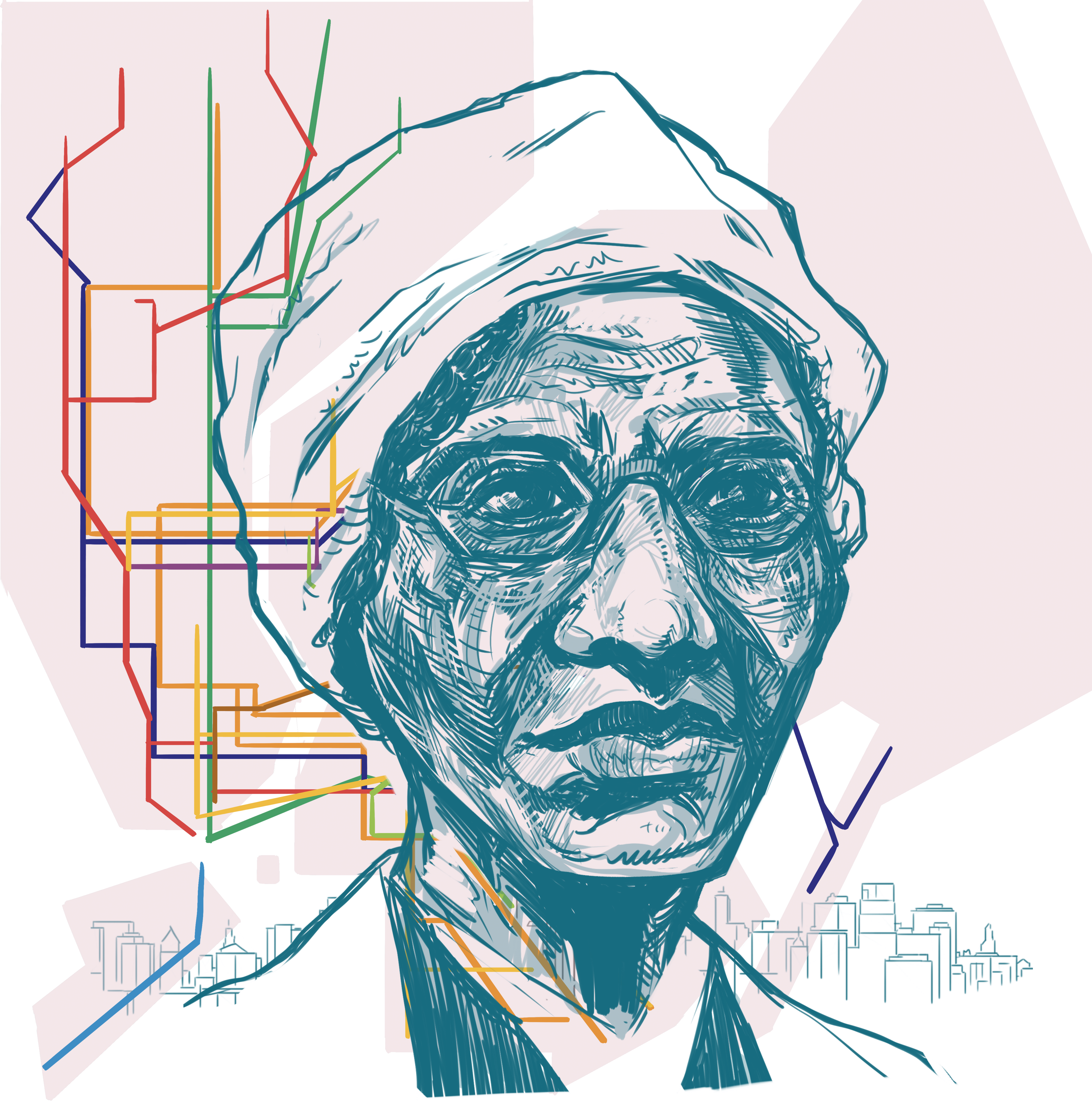
Sojourner Truth was born to enslaved parents in a Dutch community in Ulster County, NY in 1797. She was the first black woman to successfully bring a lawsuit against a white man for illegally selling her 5-year-old son after the NY antislavery law passed. She won her son back and went on to become a powerful activist in NYC. Illustration by: Veronika Hammond
JJS: Sojourner Truth is, well, Sojourner Truth: a totemic antebellum abolitionist and advocate for women’s rights, who was born into slavery in upstate New York, but lived and worked in the city (and on what’s now the Lower East Side, at 74 Canal St.) after gaining her freedom.
AH: Thanks so much for including Ms Truth! The next person I was surprised to hear about was Victoria Woodhull. In addition to her and her sister being the first women to open up their own brokerage firm, to find out that she was the first woman to announce her candidacy for president. I’ve never heard of her before this map.
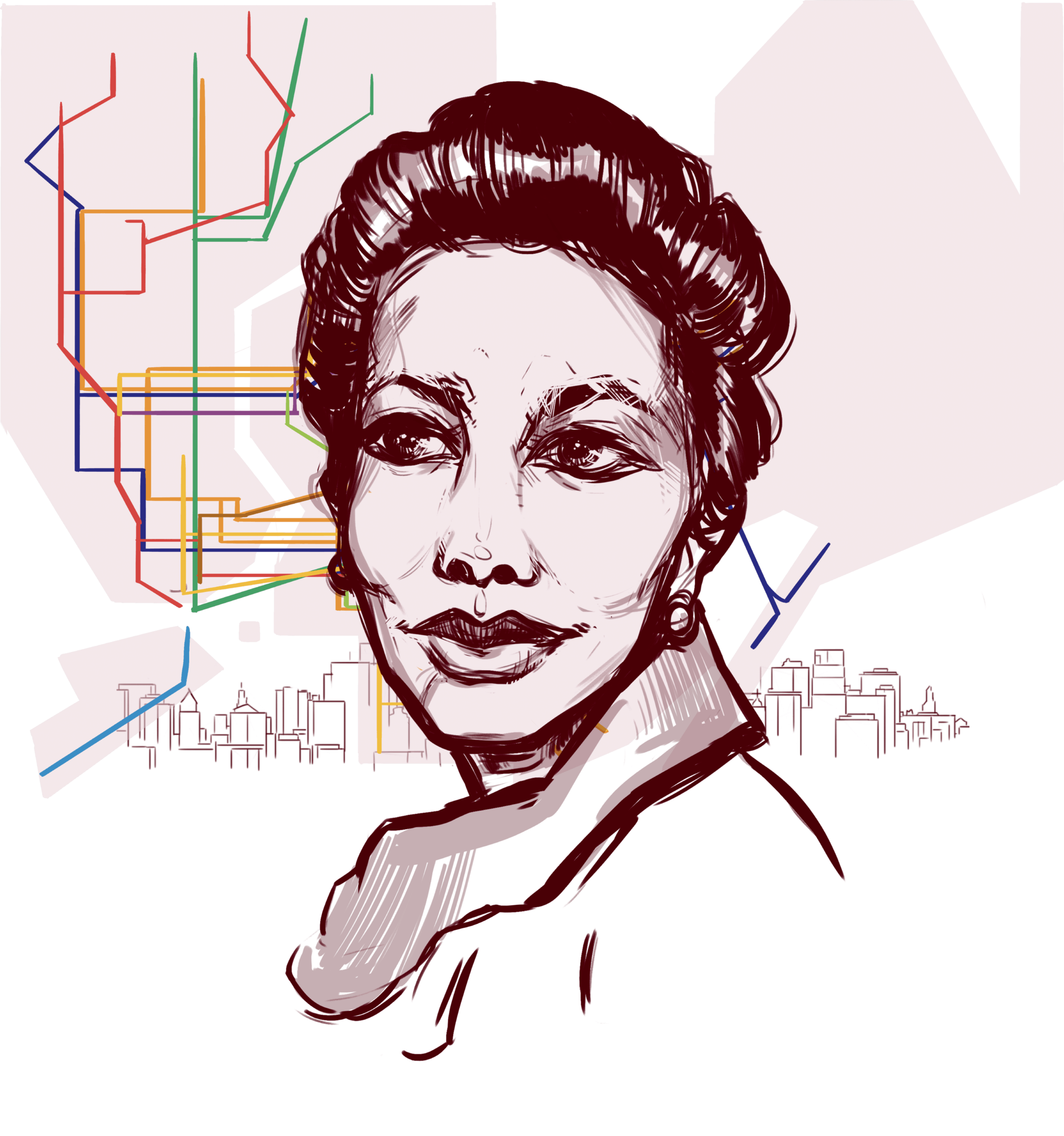
Ella Baker was a civil rights leader who led with a quiet strength. She spent nearly a half a century raising the political consciousness of Americans playing a major role in three of the 20th century’s most influential civil rights groups—The NAACP, SCLC and SNCC. She went on to become the first woman elected as President of the NAACP NY chapter in 1952. Illustration by: Veronika Hammond
JJS: Ella Baker, in similar ways but a quite different realm, was a giant who isn’t well-enough known. She was, alongside and after Martin Luther King, one of the most important leaders and organizers of the Civil Rights movement—through her involvement with the National Association for the Advancement of Colored People (NAACP), Southern Christian Leadership Conference (SCLC), and Student Nonviolent Coordinating Committee (SNCC) alike—but she wasn’t someone who sought the limelight, or who was allowed to shine in the same way as her male peers. And she lived for years in Harlem. She was an absolute must on the map.
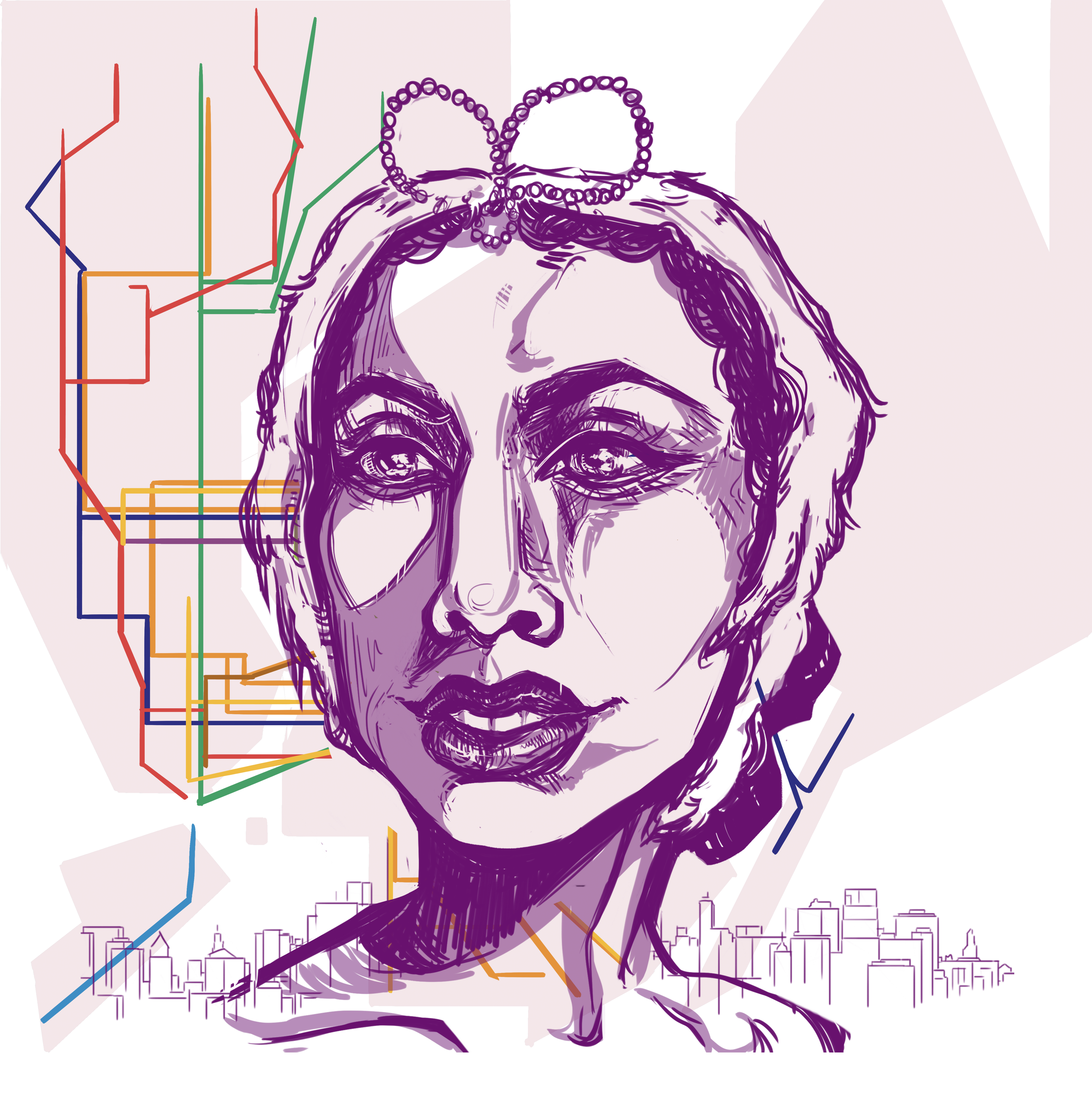
Maria Tallchief moved to NYC to pursue her dreams of becoming a dancer. Many of the dance companies discriminated against her because of her Native American ancestry. She eventually became prima ballerina and not only broke barriers for Native Americans but also became one of the only Americans recognized in European ballet companies. Illustration by: Veronika Hammond
AH: Choosing a woman for the Lincoln Center stop had to be quite the challenge? How did you decide on Maria Tallchief?
JJS: Lincoln Center is an area of the city where we also had so many choices—so many great performers, and figures in the arts, have left their mark on that corner of Manhattan. But it was an extra pleasure to name the 66th Street stop for Maria Tallchief: a mighty dancer—America’s first major prima ballerina, who is also a historic figure, as a Native American (she was a member of the Osage nation, born in Oklahoma) who unsettles modern expectations about who America’s indigenous people are and what they do.
AH: Currently there’s a City of Women 2.0 map out. How did you choose the names for the updated version?
JJS: Some new additions were clear—people who’ve risen to prominence in the past couple of years (e.g. Alexandra Ocasio Cortez), who we had to include. Others were people that we somehow left off the first version, but who are women we admire and had to get on this time around, say, Jacqueline Woodson, a great writer who’s also a great BROOKLYN writer. Beyond that, we did a lot of consulting with friends and contacts around the city, about local heroes or community leaders who we might not know about, but who have that recognition—or SHOULD have that recognition —in their own communities.
AH: When I look through a lot of the names on the map a lot of political and entertainment figures jump out. Did you consider any from the science fields?
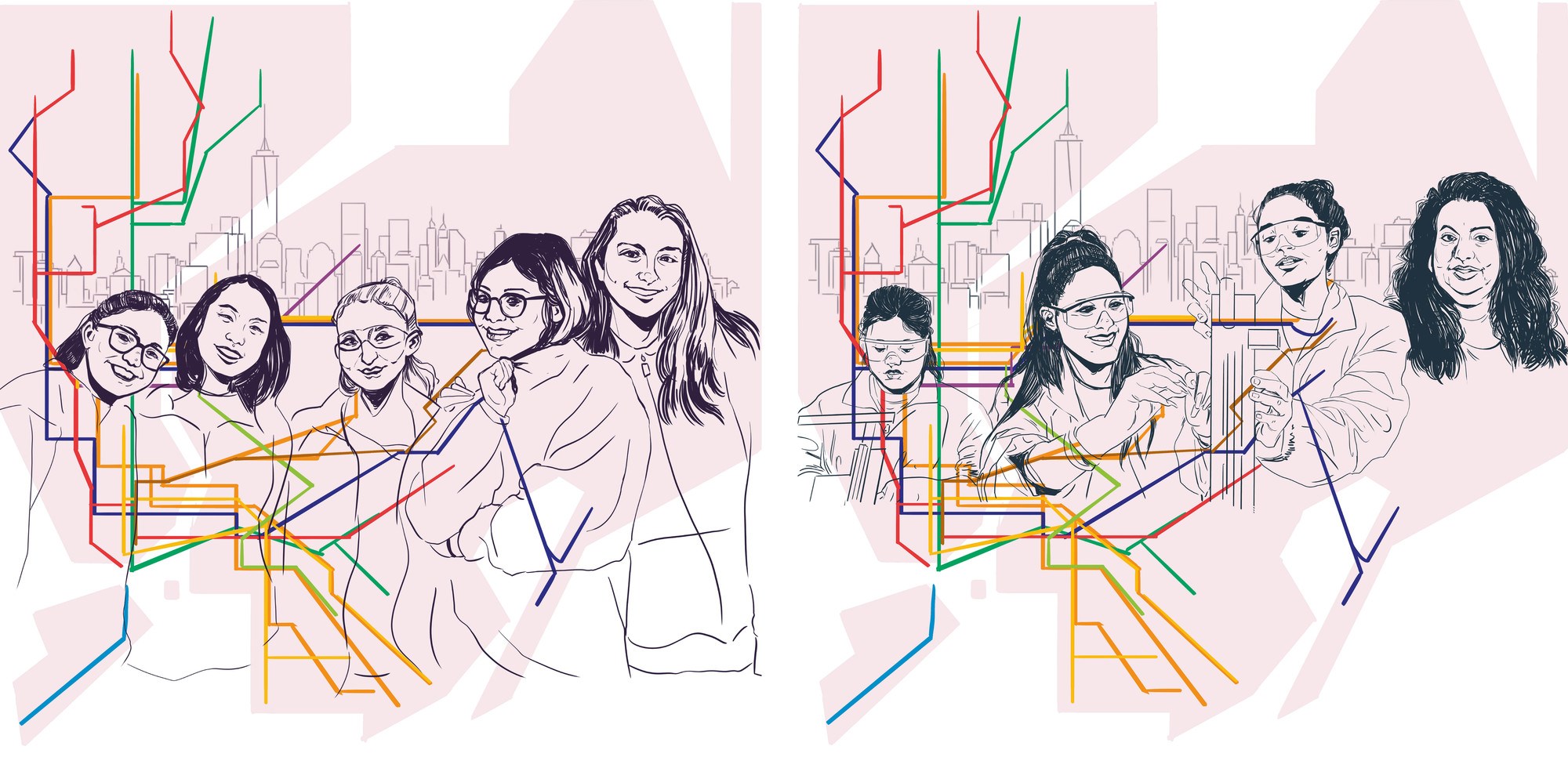
On the left, The FE Maidens is an all girls first FRC robotics team from the Bronx High School of Science in Bronx, NY. It was founded in December 2006 in an effort to encourage girls to explore and pursue STEM fields. On the right, St. Catharine’s Comets led by coach Sheree Petrignani, are trying to topple that imbalance and prove to their mostly-male opponents, their families, and themselves, that they belong in competitive robotics, in coveted college engineering programs, and eventually in the profession as expert programmers, designers, and creators in STEM fields. Illustration by: Veronika Hammond
JJS: The stop we’ve named for the All-Girl Robotics Teams, one of the new stops on 2.0, honors the two mighty all-girl robotics teams at Bronx high schools (at St. Catherine’s and at Bronx Science). We hear often that young women and girls don’t excel in STEM—but it’s hard to picture a better icon of them doing just that than kicking ass at robotics. And the Bronx, it would seem, is the national capital of girls kicking ass at robotics!
AH: Why do you think the map is important during this time?
JJS: These questions, around the particular histories and people who are honored in public space—and those that denigrated, or made unwelcome, as a result—have grown much more prominent in our national life in recent years. We’ve been gratified by the first map’s role in some of those conversations, and we’ll be thrilled if the second version can continue feeding these vital conversations.
AH: Do you have plans to update again?
JJS: No! 2.0 is it! It’s a snapshot of this moment, admittedly subjective, but the intervention and gesture we wanted to make has been made, and made in a complete way for now. If the map inspires others to do similar work, or advance conversations around actual efforts to think about building new memorials and place-names in public space, we’re thrilled.
AH: Why do you think telling women’s stories in this way is important? What do you hope people will take away from the book and the map?
JJS: Nonstop Metropolis, like all three atlases in the “Infinite Cities” trilogy, is predicated on the idea that every single person who lives in a city could map it in their own way. The city, this place of radical coexistence, contains at least as many maps as it does people. It’s also based in the idea that a great paper map—an object of beauty that’s always an amazing way to organize information, and tell a story—has a unique power to surface hidden histories, to help us see place in new ways.
The “City of Women” map aims to educate and to open eyes (“I didn’t know that so-and-so grew up in Flatbush!), and also to provoke questions: why ARE so few pieces of public infrastructure and so few public monuments or public places of any kind, named for women? And how does this lack—this imbalance—impact our understanding both of history and of what’s possible now? How might we behave or think differently in a city whose public spaces did more to honor the rights and contributions of women and girls?
"Names offer really powerful signals about what we value as a society, about the histories that we avow, about the histories that we want to push under the rug, and I think it’s an incredibly powerful and overdue conversation we’re having now about who are the people that we celebrate in public space and how does that shape how we experience those places."
I truly enjoyed my conversations with Joshua. I had the opportunity to attend the unveiling of City of Women 2.0 at the NY Transit Museum. He joined Julie Scelfo for a “station-side” chat that celebrated women who have shaped New York City from the very beginning. This is where I learned about the accomplishments of Ella Baker, Victoria Woodhull, and Maria Tallchief. It was a lively conversation and one highlight was Concetta Bencivenga, the director of the museum, nominating Elizabeth Jennings Graham to be added to the “City of Women” map. I wholeheartedly agree that her strength and poise in standing up for her right to use New York’s public transportation, more than a century before Rosa Park’s courageous stand, earns her a place on the map.
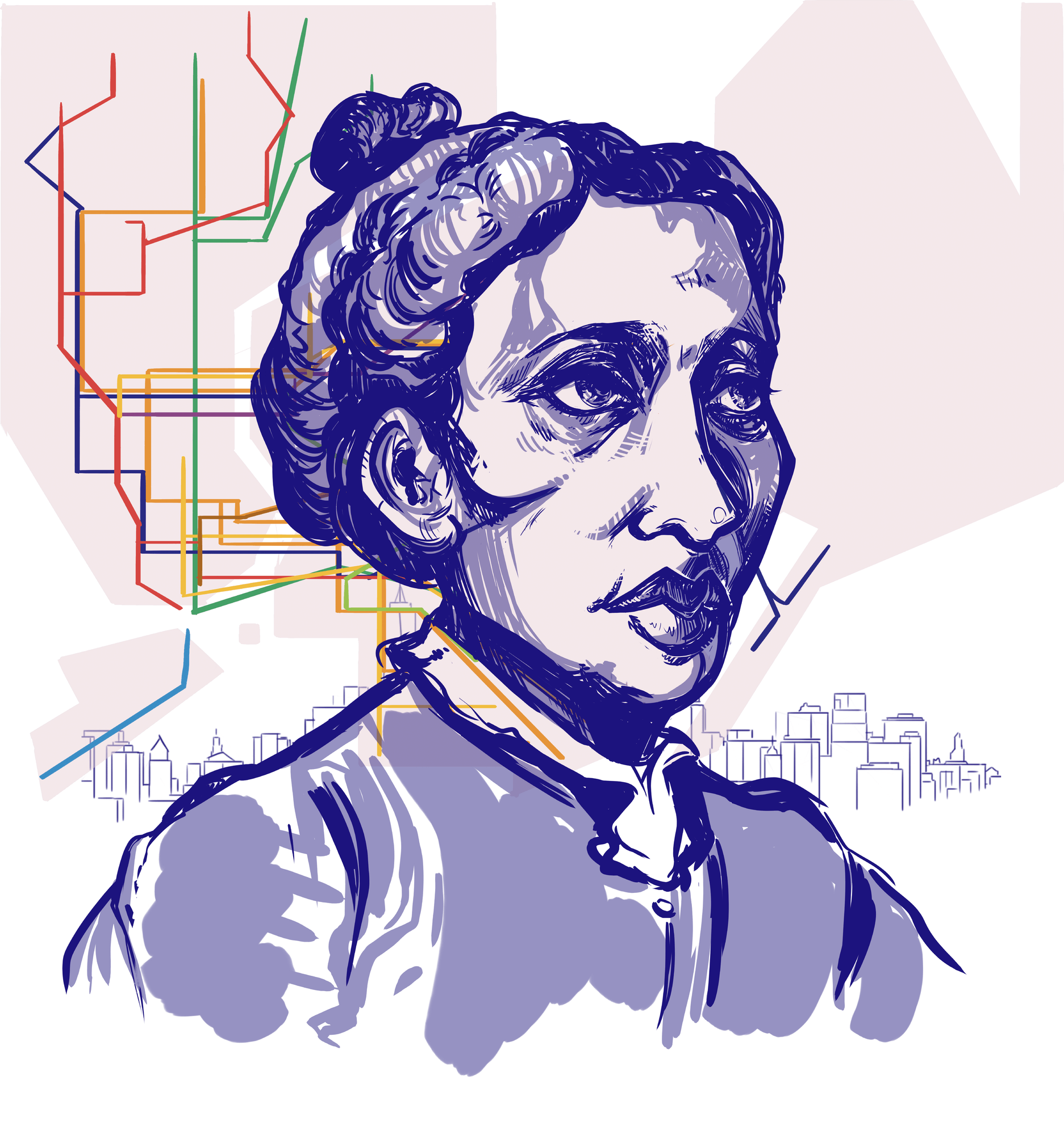
Elizabeth Jennings Graham helped to desegregate public transportation in NYC when she denied requests to leave a street car and was forcibly removed in 1854. Graham sued the private Brooklyn based Third Ave Railroad Company, the conductor and driver and won. All public transportation in New York went on to be desegregated by 1865. Illustration by: Veronika Hammond
One final trailblazer I would like to honor is Diahann Carroll. Ms Carroll passed away October 4, 2019. She’s an Oscar nominated actress and singer who won critical acclaim as the first black woman to star in a non-servant role in a TV series as “Julia.” She played a nurse whose husband had been killed in Vietnam, in the groundbreaking situation comedy that aired from 1968 to 1971. NBC executives were wary about airing the sitcom during the racial unrest of the 1960’s but it was an immediate hit.
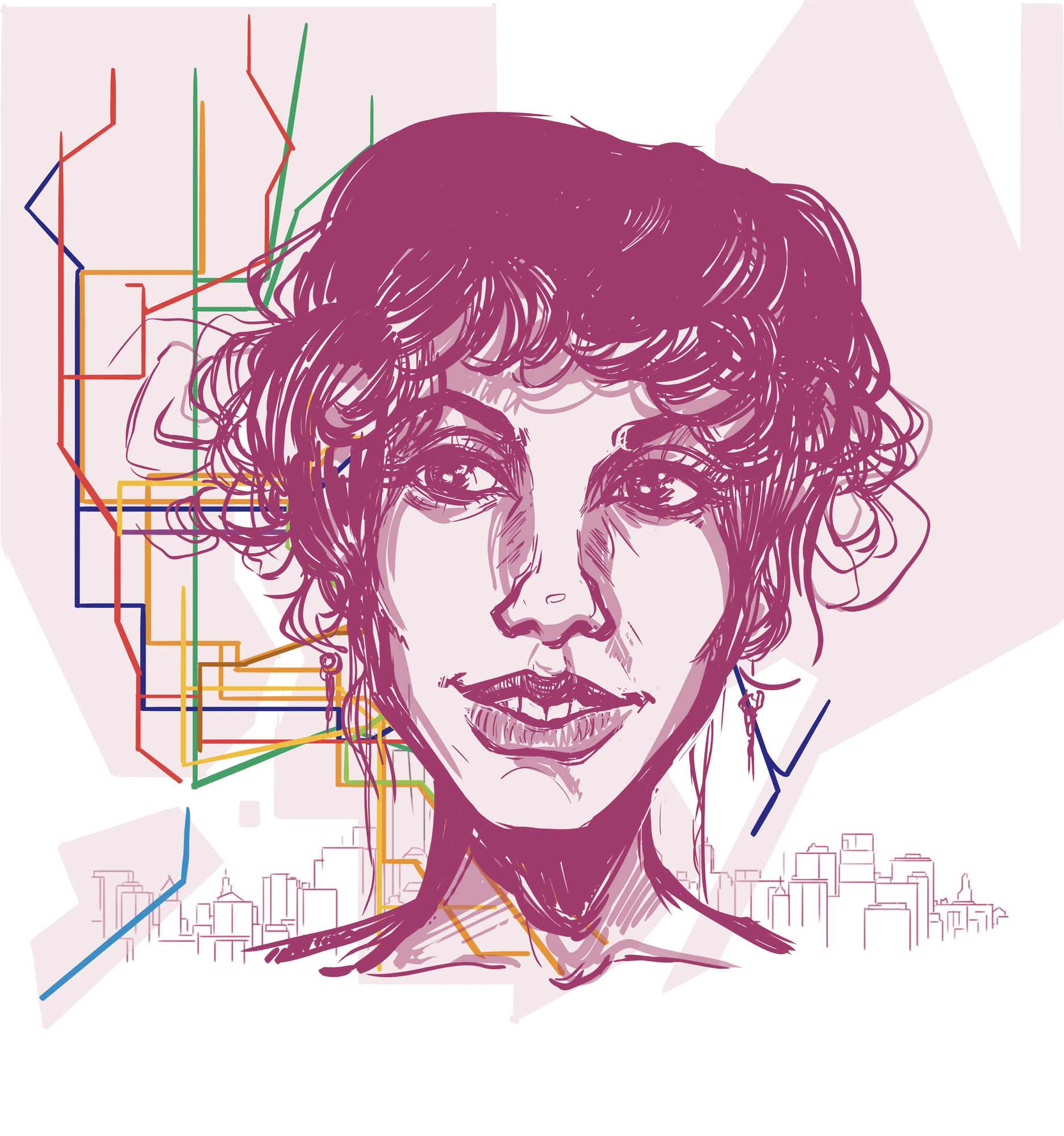
Diahann Carroll is an Oscar nominated actress and singer who won critical acclaim for her role in the TV series, “Julia” where she played a nurse and single mom whose husband had been killed in Vietnam. Carroll is a trailblazer for being the first black woman to star in a non servant role in a TV series. Illustration by: Veronika Hammond
Cartography is the study and practice of making maps and combining science, aesthetics, and technique to provide a sense of place and where we are going. There are only five historical statues of women in NYC—Joan of Arc, Golda Meir, Gertrude Stein, Eleanor Roosevelt, and Harriet Tubman. Until 1984, there was only one, installed in 1915. There is a Shirley Chisholm monument in the design process as of April 2019.
Rebecca Solnit and Joshua Jelly-Schapiro set out to help us by showcasing the way a map can help us see our city in a different way. New York City has been seen as a powerful, wealthy, and industrious city for so long. Beneath that veneer, however, lies a resilience, fearlessness, and strength that echoes from the women who have also walked this city.
I would like to say a huge thank you to Chelsea Newburg and Kathleen Hulser from the NY Transit Museum! They helped with answering all of my questions about the exhibit and connecting me with Josh Schapiro!
Histórias relacionadas
Subscribe to our blog
Receba em sua caixa de entrada as atualizações mais recentes do Tableau.









